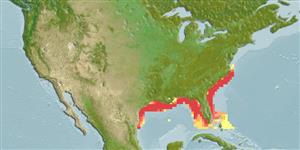Environment: milieu / climate zone / depth range / distribution range
นิเวศวิทยา
เกี่ยวกับทะเล,น้ำเค็ม สัตว์น้ำหน้าดิน; ระดับความลึก 9 - 183 m (Ref. 89891). Subtropical; 37°N - 24°N, 98°W - 75°W
Western Atlantic: Chesapeake Bay to northern Florida and Gulf of Mexico from southern Florida to Texas, occasionally rounding Cape Sable to southeastern Florida in USA.
ขนาด / น้ำหนัก / Age
Maturity: Lm ? range ? - ? cm
Max length : 35.0 cm TL เพศผู้/กระเทย; (Ref. 7251)
Very common in bays. Young occur in estuaries.
Life cycle and mating behavior
วัยเจริญพันธุ์ | การสืบพันธุ์ | การวางไข่ | เซลสืบพันธ์ของเพศเมีย(ไข่) | ความดกของไข่ | ตัวอ่อน
Robins, C.R. and G.C. Ray, 1986. A field guide to Atlantic coast fishes of North America. Houghton Mifflin Company, Boston, U.S.A. 354 p. (Ref. 7251)
IUCN Red List Status (Ref. 130435: Version 2024-2)
Threat to humans
Harmless
Human uses
เครื่องมือ
Special reports
Download XML
แหล่งที่มาจากอินเตอร์เน็ต
Estimates based on models
Preferred temperature (Ref.
123201): 21 - 26.4, mean 24.1 °C (based on 170 cells).
Phylogenetic diversity index (Ref.
82804): PD
50 = 0.5000 [Uniqueness, from 0.5 = low to 2.0 = high].
Bayesian length-weight: a=0.00525 (0.00223 - 0.01237), b=3.13 (2.92 - 3.34), in cm total length, based on LWR estimates for this (Sub)family-body shape (Ref.
93245).
ระดับชั้นอาหาร (Ref.
69278): 3.7 ±0.6 se; based on size and trophs of closest relatives
ความสามารถในการกลับคืนสู่ปกติ (Ref.
120179): ขนาดกลาง, เวลาต่ำสุดที่จะทำให้ประชากรเพิ่มขึ้นเป็น 2 เท่าใช้เวลา 1.4 - 4.4 ปี (Preliminary K or Fecundity.).
Fishing Vulnerability (Ref.
59153): Low vulnerability (25 of 100).
Nutrients (Ref.
124155): Calcium = 107 [52, 230] mg/100g; Iron = 1.22 [0.64, 2.33] mg/100g; Protein = 16.5 [14.2, 19.5] %; Omega3 = 0.35 [0.17, 0.94] g/100g; Selenium = 33 [16, 86] μg/100g; VitaminA = 23.3 [8.0, 68.4] μg/100g; Zinc = 0.746 [0.510, 1.108] mg/100g (wet weight);
